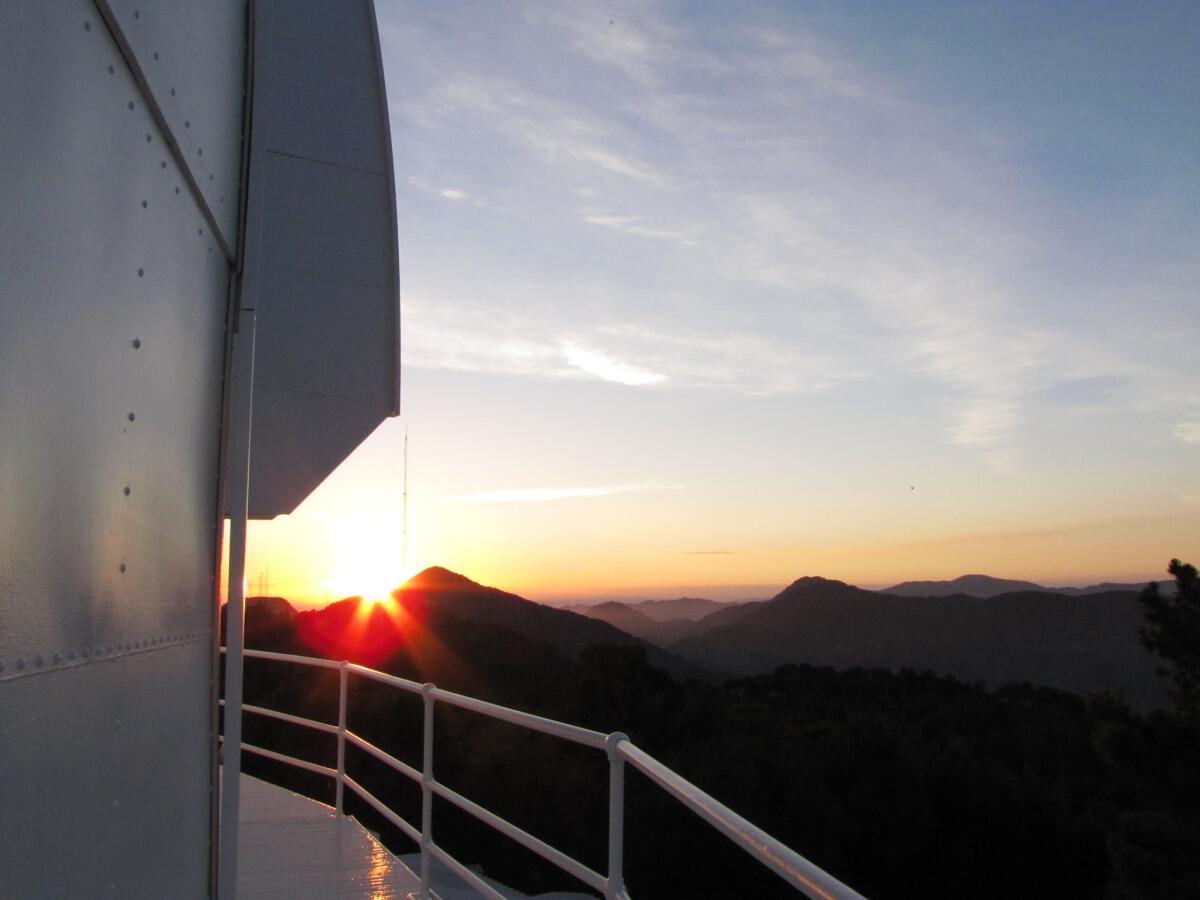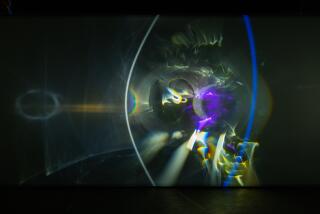L.A.’s Mt. Wilson Observatory inspires the future of cosmology

- Share via
The first thing I notice as we climb the steep stairs is an old hand crank telephone — the kind that looks like a face with two brass bells for eyes and a black trumpet for a mouth. It sits in a cubby along with a rotary telephone from the 1950s and a push-button model from the end of last century. These artifacts neatly encapsulate the long history of this remote, cavernous building and the treasure it contains.
------------
FOR THE RECORD
Aug. 5, 2:27 p.m.: An earlier version of this post stated that the mirrors for the Giant Magellan Telescope cost $200 million each. They cost $20 million each. It also stated that Edwin Hubble used the Hooker Telescope to discover that the Earth is not at the center of the universe. Harlow Shapley used another telescope on Mt. Wilson to determine that the Earth is not at the center of the Milky Way galaxy. The post also referred to the Hooker Telescope’s 100-inch lens and said it weighed 2 tons and was 4 feet thick. Its mirror weighs 4½ tons and is 12 inches thick.
------------
“This is where probably the most profound discoveries in science were ever made,” says Patrick McCarthy, his voice bouncing off the room’s bare metal rafters and rusted walls. “Maybe the most profound since Galileo.”
McCarthy is an astronomer at the Carnegie Institution for Science in Pasadena whose new project, the Giant Magellan Telescope (GMT), hopes to push his field of science into the future.
He is standing with me beneath the yawning dome of the Mt. Wilson Observatory, looking out at the cantilevered cylinder of the century-old Hooker Telescope. Its 100-inch mirror — a 4.5-ton disc of Coke-bottle glass, 12-inches thick — sits encased in a towering turquoise skeleton. Studded with rivets, its steel beams betray the fact that it was fashioned by the same hands that built battleships for the United States Navy.
“This is where modern cosmology began,” McCarthy says, surveying the room affectionately.
In the 1920s, Edwin Hubble spent years at Mt. Wilson peering through the eyepiece of the telescope with the observatory doors swung wide to let in the night. Here, he discovered that the universe extended far beyond the confines of the Milky Way galaxy. That came a few years after Harlow Shapley used Mt. Wilson’s 60-inch telescope to determine that the Earth was not at the center of the Milky Way. These realizations transformed the field of astronomy.
Albert Einstein visited later, in 1931, to work on his new theory of general relativity. Thanks to Hubble’s observation that faraway galaxies appeared to be racing away from us — a sign that the universe was expanding — Einstein abandoned the “cosmological constant” he had introduced to hold the universe together. With that, he unveiled the complete theory of relativity, transforming nearly everything we know about the physical world.
Now, on a Saturday afternoon in July, McCarthy is here because he hopes the GMT will be the Hooker Telescope of the 21st Century — the one that untangles the unseen mysteries of the dark universe, that finds evidence of extraterrestrial life, that sees back to the first hushed moments after the Big Bang.
But he also hopes the GMT will do more than that.
“We build telescopes in part because we know it will enable us to discover new and unexpected things,” he said.
“When this telescope was built,” he said, gesturing to the Hooker, “no one had any idea it would revolutionize our whole thinking about the universe.”
::
The idea for the GMT arose in 2003 as it became clear to scientists that they would need better tools to answer cosmology’s most pressing questions. When completed, it will be one of the largest telescopes ever built, and it will join the cadre of Carnegie’s other telescopes staring up at the sky over a remote part of the Chilean desert.
The GMT’s unique design combines seven mirrors that each measure 25 feet across. They will be arranged like a flower to achieve a resolution 10 times greater than that of the Hubble Space Telescope.
“It can see a dime at 200 miles and a candle on the moon,” says McCarthy.
Of course, what they actually hope to see with the GMT are the slight movements of faraway stars that betray the presence of Earth-like exoplanets. They hope to scour their atmospheres for evidence of biological gases and to peer deeper into the universe’s murky past than ever before — back to when it had only doubled in size a handful of times.
But before the team could break ground, they had to prove the telescope could be built. The massive mirrors represented an unprecedented technical challenge.
To tackle it, they enlisted the help of the Steward Observatory Mirror Lab at the University of Arizona. Scientists there specialize in making telescope mirrors that have a honeycomb structure sandwiched between two layers of Pyrex-like glass.
This makes them light enough to be practical even when they’re 25 feet tall. They also make them incomprehensibly smooth.
“If you blew each mirror up to the size of the U.S.,” McCarthy says, “the biggest imperfection would be half an inch.”
The Arizona lab finished the first mirror in 2012, and three more are on the way. (Each one costs $20 million and takes 4 years to complete.) Having crossed this hurdle, crews have already started to excavate a construction site in Chile, and the first parts are scheduled to arrive in 2018. McCarthy hopes the telescope will see “first light” by 2021.
::
A few minutes before 5 o’clock, we emerge from the dark vault into the soft evening light. Puddles of shade pool on the ground, cast by live oak and sugar pine. A squirrel flaunts his resplendent tail as he scurries past.
At this moment, it’s hard to believe we are just 25 miles from Los Angeles and its millions of residents. But when night falls, it becomes undeniably obvious — light pollution expelled astronomers from Mt. Wilson in the 1960s. They have gathered now in more far-flung places like Hawaii’s volcanic peaks and Chile’s Atacama Desert.
All three spots share the kind of geography that makes for great observing: a mountain that rises straight out of the flat sheet of the ocean, where the atmospheric flow is smooth and well-behaved, devoid of the shimmering dance astronomers call “seeing.”
On this evening, a few shreds of high clouds have blown in on the dry breeze, causing McCarthy to scowl as we pad across a suspended bridge. We pass a submerged tank that holds half a million gallons of firefighting water and a gaggle of hikers who have stopped to admire a framed photo of Einstein standing in this very spot. We are en route to meet a black bus that has just arrived from Pasadena.
Two dozen visitors have come at McCarthy’s invitation: a few fellow scientists, but mostly development officers from Carnegie’s institutional partners and a small hand-picked crowd of potential donors.
They file out, glad to be off the winding mountain road and free of the oppressive summer heat a mile beneath us. They are engineers, real estate developers, trustees of major universities. Many are also amateur astronomers who might, McCarthy hopes, find the GMT and its mission worthy of their support.
::
The project is slated to cost close to $900 million. So far, the GMT team has raised a little more than half from its institutional partners — Harvard, the Smithsonian, the University of Chicago, Texas A&M, and the University of Texas, Austin — and its international collaborators in Australia, South Korea, Brazil and Chile.
Conspicuously missing from this list is the National Science Foundation. At the moment, it simply cannot support endeavors of this scale, the agency announced in 2012. Only NASA has such deep pockets, and it has poured its resources into the new James Webb Space Telescope, an 18-foot infrared telescope set to launch in 2018.
This evening set in the leafy solitude of Mt. Wilson is designed to help the drum up some of what the GMT still needs to succeed.
After a simple meal of boxed sandwiches, the visitors gather for an informal discussion inside a quaint auditorium. It has the folding wooden seats and steeply pitched walls of a country church, and the sounds of birdsong filter in through the open doors.
McCarthy and two other scientists, Mike Gladders from the University of Chicago and John Mulchaey, also of Carnegie, hold forth on the reasons to build the GMT. For one, it’s based on land, which costs about 500 times less than launching the same telescope into orbit, McCarthy says. It also makes it possible to fix and update the instrument throughout its lifetime. Its location offers another bonus: without any water, the Atacama is unlikely to turn into a Los Angeles-sized metropolis any time soon.
As the sun begins to set, the group strolls across the empty grounds toward Mt. Wilson’s 60-inch telescope, Hooker’s predecessor that the nonprofit Mt. Wilson Institute makes available for public events.
In reality, the GMT isn’t the only game in town. Caltech and the UCs have partnered with China and Japan on a new project called the Thirty Meter Telescope, which they plan to build in Hawaii. As its name implies, it will trump GMT’s span by about 20 feet. In addition, scientists across the Atlantic are working hard to push the 130-foot wide European Extremely Large Telescope into operation, which will also be based in Chile.
“There are extraordinary prizes out there,” says Gladders as we walk. He is tall and lumbering, with the booming voice of a Shakespearean actor and a tattooed band around his right forearm. He says he’d be happy if the GMT helps claim them, but in the end, he says, it’s a friendly sort of competition. He just wants to see the science move forward, and it will take one of these next-generation telescopes to do it.
Inside the rotunda of the 60-inch observatory, the operator opens the dome’s roof and aims the telescope at the sky. The clouds make a mess of Mars, but he seems excited when he gets Saturn in the sights.
One by one, each visitor climbs a rickety yellow ladder and leans precariously over the eyepiece. Hulking and cool to the touch, it feels like looking into the blowhole of an interstellar whale.
Inside, captured by a piece of glass cast in 1894, the mesmerizing sphere floats on a soft velvet background. Compared to the GMT, this telescope is little better than our naked eyes, but even so, there sits Saturn and all its rings, big enough to pinch between your fingers and perfectly clear.
For all things science, follow me @ScienceJulia







